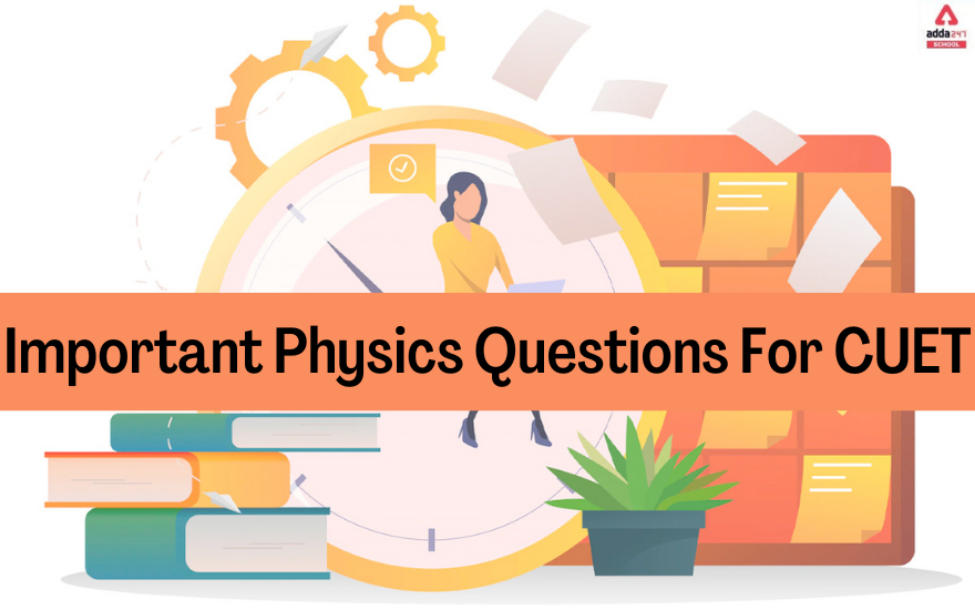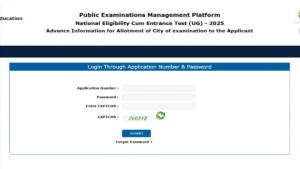Table of Contents
CUET Physics Important Questions
Important Physics Questions for CUET: Section II of the CUET exam is the domain-specific subject section. This section is very vast and includes the subject of physics and today we are going to cover this subject in today’s article. We will provide you with a list of physics important questions from CUET’s point of view. Check here some Physics asked important question in CUET 2022 exam.
CUET Physics Syllabus and Structure
The CUET test is almost approaching. Students taking this test must be well-versed in the CUET syllabus. CUET is divided into three sections. Part I is the language section (IA and IB), Section II is the core topics (or domain-specific subjects), and Section III is a broad test. One of the 27 core courses in the second section is CUET Physics. Multiple Choice Questions (MCQs) of various difficulty will be included in the exam. The NCERT Class 12 syllabus is used for the CUET-UG. As a result, students who have recently taken their Class 12 CBSE Boards should not feel overwhelmed; by preparing online examinations, one
may simply do well. Let’s take a brief glance at the CUET Physics curriculum and see what subjects are frequent and rare.
● Unit I: Electrostatics
● Unit II: Current Electricity
● Unit III: Magnetic Effects of Current and Magnetism
● Unit IV: Electromagnetic Induction and Alternating Currents
● Unit V: Electromagnetic Waves
● Unit VI: Optics
● Unit VII: Dual Nature of Matter and Radiation
● Unit VIII: Atoms and Nuclei
● Unit IX: Electronic Devices
● Unit X: Communication Systems
CUET Physics Questions with Solutions
Q1.Charges is the property associated with matter due to which it produces and experiences
(a) electric effects only
(b) magnetic effects only
(c) both electric and magnetic effects
(d) None of these
Q2. Field due to multiple charges at a point is found by using
I. superposition principle.
II. Coulomb’s law.
III. law of conservation of charges.
(a) I and II
(b) II and III
(c) I and III
(d) I, II and III
Q3. A given charge is situated at a certain distance from an electric dipole in the end-on position
experiences a force F. If the distance of the charge is doubled, the force acting on the change
will be
(a) 2F
(b) F / 2
(c) F / 4
(d) F / 8
Q4. It becomes possible to define potential at a point in an electric field because electric field
(a) is a conservative field
(b) is a non-conservative field
(c) is a vector field
(d) obeys principle of superposition
Q5. Consider the following statements and select the correct option
I. In an external electric field, the positive and negative charges of a non—polar molecule are
displaced in opposite directions.
II. In non—polar molecules displacement stops when the external force on the constituent
charges of the molecule is balanced by the restoring force.
III. The non—polar molecule develops an induced dipole moment.
(a) I and II
(b) II and III
(c) I and III
(d) I, II and III
Q6. A current passes through a wire of nonuniform cross-section. Which of the following
quantities are independent of the cross-section?
(a) The charge crossing
(b) Drift velocity
(c) Current density
(d) Free-electron density
Q7. Huygen’s concept of secondary wave
(a) allows us to find the focal length of a thick lens
(b) is a geometrical method to find a wavefront
(c) is used to determine the velocity of light
(d) is used to explain polarization
Q8. Which of the following statements are incorrect?
I. The order of magnitude of current flowing in household appliances is one ampere.
II. The order of magnitude of current in lightening is about one ampere.
III. The order of magnitude of current in nerves in human body is one ampere.
(a) II and III
(b) I and II
(c) I and III
(d) I, II and III
Q9. A straight conductor of uniform cross-section carries a current I. If is the specific charge of
an electron, the momentum of all the free electrons per unit length of the conductor, due to their
drift velocity only is
(a) I s
(b)
(c) I / s
(d) 2
Q110. Electric conduction in a semiconductor takes place due to
(a) electrons only
(b) holes only
(c) both electrons and holes
(d) neither electrons nor holes
Q11. A ferromagnetic material is heated above its curie temperature. Which of the following are
incorrect?
I. Ferromagnetic domains are perfectly arranged
II. Ferromagnetic domains are not influenced
III. Ferromagnetic material changes into diamagnetic material
(a) I and II
(b) I, II and III
(c) II and III
(d) I and III
Q12. A proton and a deuterium nucleus having certain kinetic energy enter in a uniform
magnetic field perpendicular to it. Which of the following statements are incorrect?
I. Proton has more frequency of revolution.
II. Deuterium nucleus has more frequency of revolution.
III. The particle which has greater speed has more frequency of revolution.
(a) I and II
(b) II and III
(c) I and III
(d) I, II and III
Q13. The metal knob of a gold leaf electroscope is touched with a positively charged rod. When
it is taken away the leaves stay separated. Now the metal knob is touched by negatively
charged rod. The separation between the leaves
(a) increases
(b) decreases
(c) remains same
(d) first increases then decreases.
Q14. The magnetic field due to a current carrying circular loop of radius 3 cm at a point on the
axis at a distance of 4 cm from the centre is 54 μT. What will be its value at the centre of loop?
(a) 125 μT
(b) 150 μT
(c) 250 μT
(d) 75 μT
Q15. Magnetic lines of force due to a bar magnet do not intersect because
(a) a point always has a single net magnetic field
(b) the lines have similar charges and so repel each other
(c) the lines always diverge from a single force
(d) the lines need magnetic lenses to be made to interest
Q16. The work done in turning a magnet of magnetic moment M by an angle of 90° from the
meridian, is n times the corresponding work done to turn it through an angle of 60°. The value of n is given by
(a) 2
(b) 1
(c) 0.5
(d) 0.25
Q17. An infinitely long cylinder is kept parallel to an uniform magnetic field B directed along
positive z axis. The direction of induced current as seen from the z axis will be
(a) zero
(b) anticlockwise of the +ve z axis
(c) clockwise of the +ve z axis
(d) along the magnetic field
Q18. An induced e.m.f. is produced when a magnet is plunged into a coil. The strength of the
induced e.m.f. is independent of
(a) the strength of the magnet
(b) number of turns of coil
(c) the resistivity of the wire of the coil
(d) speed with which the magnet is moved
Q19. Two coils are placed close to each other. The mutual inductance of the pair of coils
depends upon
I. relative position and orientation of the two coils
II. the materials of the wires of the coils
III. the rates at which currents are changing in the two coils
Which of the above statements is/are correct?
(a) I only
(b) II only
(c) I and III
(d) II and III
Q20. A.C. power is transmitted from a power house at a high voltage as
(a) the rate of transmission is faster at high voltages
(b) it is more economical due to less power loss
(c) power cannot be transmitted at low voltages
(d) a precaution against theft of transmission lines
Q21. In order to establish an instantaneous displacemet current of 1 mA in the space between
the plates of 2μF parallel plate capacitor, the potential difference need to apply is
(a) 100
(b) 200
(c) 300
(d) 500
Q22. Which of the following statements are correct?
I. If the resonance is less sharp, not only is the
maximum current less, the circuit is close to resonance
for a larger range ���� of frequencies and the tuning
of the circuit will not be good.
II. Less sharp the resonance less is the selectivity of
the circuit or vice–versa.
III. If quality factor is large, i.e., R is low or L is large,
the circuit is more selective.
(a) I and II only
(b) II and III only
(c) I and III only
(d) I, II and III
Q23. 106. In an LR circuit f = 50 Hz, L = 2H, E = 5 volts, R = 1 �� then
energy stored in inductor is
(a) 50 J
(b) 25 J
(c) 100 J
(d) None of these
Q24. If a variable frequency ac source connected to a capacitor then with decrease in
frequency, the displacement current will
(a) increase
(b) decrease
(c) remain constant
(d) first decrease then increase
Q25. Which of the following is/are true for electromagnetic waves?
I. They transport energy.
II. They have momentum.
III. They travel at different speeds in air depending on
their frequency.
(a) I and III (b) II only
(c) I, II and III (d) I and II
Q26. The field of view is maximum for
(a) plane mirror
(b) concave mirror
(c) convex mirror
(d) cylindrical mirror
Q27. Sunlight reaches to us in composite form and not in its constituent colours because
I. vacuum is non–dispersive.
II. speed of all colours is same in vacuum.
III. light behaves like a particle in vacuum.
IV. light travels in a straght line in vacuum.
(a) I and II
(b) II and III
(c) III and IV
(d) I and IV
Q28. A rod of length 10 cm lies along the principal axis of a concave mirror of focal length 10 cm in such a way that its end closer to the pole is 20 cm away from the mirror. The length of the image is
(a) 10 cm
(b) 15 cm
(c) 2.5 cm
(d) 5 cm
Q29. Diffraction is a characteristic which is exhibited by
I. matter waves II. water waves
III. sound waves IV. light waves
(a) I and II
(b) I, II and III
(c) III and IV
(d) I, II, III and IV
Q30. The wave nature of light was established by
(i) Maxwell’s equations (ii) Fraunhoffer’s lines
(iii) Hertz experiment (iv) Einstein’s theory
(a) (i) and (ii) only
(b) (ii) and (iv) only
(c) (i) and (iii) only
(d) (iii) and (iv) only
Q31. Out of the following which one is not a possible energy for a photon to be emitted by
hydrogen atom according to Bohr’s atomic model?
(a) 1.9 eV
(b) 11.1 eV
(c) 13.6 eV
(d) 0.65 eV
Q32. Energy required by an electron for electron emission can be supplied to a free electron by
I. hammering the metal surface
II. heating the metal surface
III. applying electric field
IV. applying magnetic field
Which of the above statements is/are correct ?
(a) Only I
(b) I, II and IV
(c) II, III and IV
(d) II and II
Q33. A photocell is illuminated by a small bright source placed 1 m away. When the same
source of light is placed 2 m away, the number of electrons emitted by photocathode are
reduced by a factor of
(a) 1/8
(b) 1/16
(c) 1/2
(d) ¼
Q34. Rutherford’s α-particle scattering experiment concludes that
I. there is a heavy mass at centre
II. electrons are revolving around the nucleus
(a) I only
(b) II only
(c) I and II
(d) None of these
Q35. Two light waves superimposing at the mid-point of the screen are coming from coherent
sources of light with phase difference 3π rad. Their amplitudes are 1 cm each. The resultant
amplitude at the given point will be.
(a) 5 cm (b) 3 cm
(c) 2 cm (d) zero
Q36. A nuclei having same number of neutron but different number of protons / atomic number
are called
(a) isobars
(b) isomers
(c) isotones
(d) isotopes
Q37. Which of the following statements are correct? I. Atoms of isotopes have same electronic
structure. II. Atoms of isotopes occupies same place in periodic table.
III. Atoms of isotopes have same number of protons.
IV. Atoms of isotopes have same number of neutrons.
(a) I and II
(b) I, II and III
(c) I, II III and IV
(d) II and IV
Q38. According to the Rutherford’s atomic model, the electrons inside the atom are
(a) stationary
(b) not stationary
(c) centralized
(d) None of these
Q39. A radioactive substance has a half life of four months. Three fourth of the substance will
decay in
(a) three months
(b) four months
(c) eight months
(d) twelve months
Q40. A current is passed through a straight wire. The magnetic field established around it has
its lines of force
(a) circular and endless
(b) oval in shape and endless
(c) straight
(d) All of the above




 NEET City Intimation Slip 2025 Out at ne...
NEET City Intimation Slip 2025 Out at ne...
 NTA NEET Cut Off 2025, Expected Cutoff f...
NTA NEET Cut Off 2025, Expected Cutoff f...
 NTA NEET Admit Card 2025 Soon, Check the...
NTA NEET Admit Card 2025 Soon, Check the...




